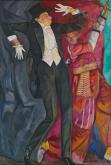Portrait of Vsyevolod Meyerhold
1916
Grigoriev's enigmatic portrait combines classical and expressionistic techniques, to which this master was drawn in equal measure. Through the plastic quality of the painting he attempts to con vey the creative process of the great director and the complexity and contradictions of his philosophical and aesthetical quests. Detached from the present, Meyerhold's intense and strange creativity comes, as it were, from a higher inspiration. Grigoriev's portrait is a specific phenomenon of the St Petersburg culture of the 1910s, characteristically theatre-centred and abounding in ideas about life as theatre and the mystical nature of the performance. Play and Passion in Russian Fine Art. St-Petersburg. 1999. P. 158.
Boris Grigoriev’s portrait of Vsyevolod Meyerhold has an unusual construction. The famous theatrical director is stands with his arms raised in a weird and warped pose, as if caught in the middle of an eccentric mise-en-scène. The allegorical figure of a hunter in oriental dress stands behind him, holding a bow. Vsyevolod Voinov called Grigoriev’s painting a «double portrait of Vsyevolod Meyerhold». He believed that it «reflected the grimaces and break-up of the modern spirit, when the nightmares of the fairground clown were preferable to the nightmares of Russian reality.»
Vsyevolod Emilievich Meyerhold (1874–1940): Theatrical director, actor. Headed experimental work under the pseudonym of Doctor Dapertutto at a studio on Borodino Street in Moscow (from 1914). Published the L’amore delle tre melarance magazine (1914–16). Directed and performed the role of Lord Henry in The Portrait of Dorian Gray, a film based on the novel by Oscar Wilde (1915). Russian Museum: From Icons to the Modern Times. Palace Editions, St Petersburg,

